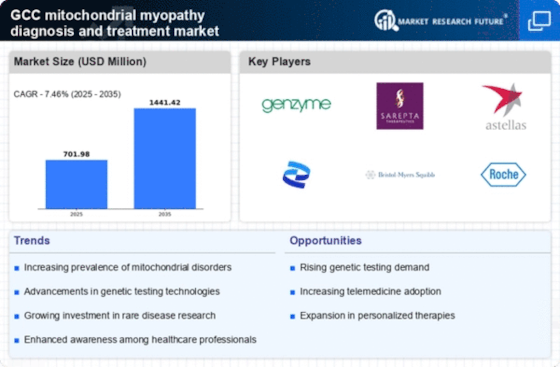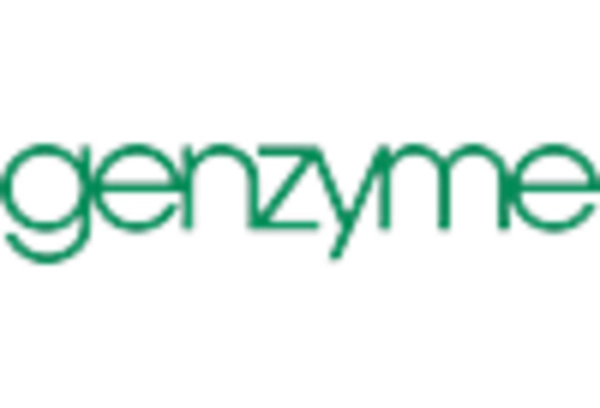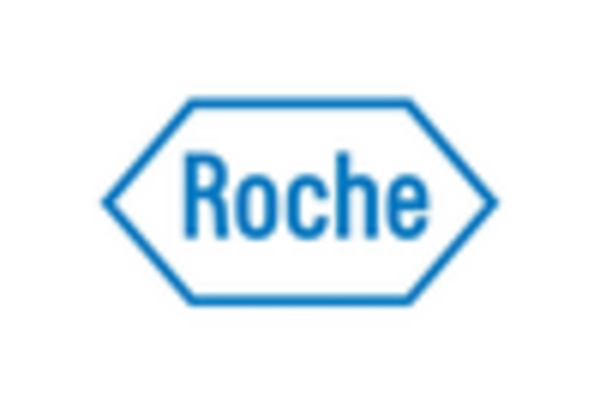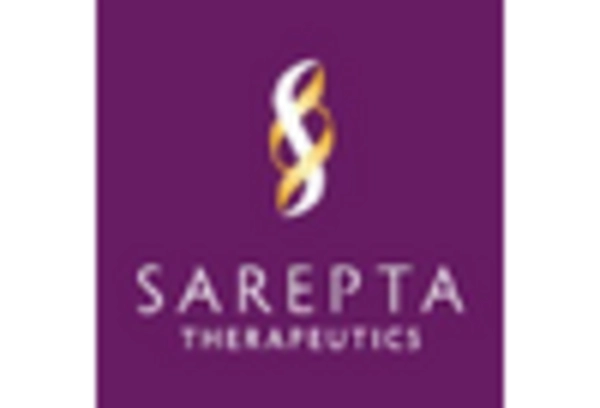Enhanced Regulatory Frameworks
The establishment of enhanced regulatory frameworks in the GCC is positively influencing the mitochondrial myopathy-diagnosis-treatment market. Regulatory bodies are increasingly recognizing the need for streamlined processes to expedite the approval of innovative therapies and diagnostic tools for rare diseases. This shift is likely to encourage pharmaceutical companies to invest in the development of new treatments for mitochondrial myopathy. Additionally, the introduction of incentives for research and development can stimulate market growth by attracting more players to the field. As regulatory environments become more conducive to innovation, the mitochondrial myopathy-diagnosis-treatment market is expected to benefit from a wider array of treatment options and improved patient access to care. The proactive approach of regulatory agencies in the GCC may lead to a more dynamic and responsive market landscape.
Growing Investment in Rare Disease Research
The growing investment in research and development for rare diseases, including mitochondrial disorders, is a significant driver for the mitochondrial myopathy-diagnosis-treatment market. In the GCC, governments and private sectors are increasingly allocating funds to support research initiatives aimed at understanding and treating rare diseases. This trend is evidenced by the establishment of specialized research centers and collaborations between academic institutions and pharmaceutical companies. The financial commitment to rare disease research not only fosters innovation in treatment options but also enhances the overall understanding of mitochondrial myopathy. As new therapies emerge from this research, the market is likely to experience substantial growth. Furthermore, increased funding can lead to the development of more effective diagnostic tools, thereby improving patient access to timely and accurate diagnoses in the mitochondrial myopathy-diagnosis-treatment market.
Advancements in Genetic Testing Technologies
Technological advancements in genetic testing are significantly impacting the mitochondrial myopathy-diagnosis-treatment market. Innovations such as next-generation sequencing (NGS) and whole-exome sequencing (WES) have revolutionized the diagnostic landscape, allowing for more accurate and timely identification of mitochondrial disorders. In the GCC, the adoption of these technologies is increasing, with healthcare providers recognizing their potential to enhance patient outcomes. The ability to diagnose mitochondrial myopathy at an earlier stage can lead to more effective treatment strategies, thereby driving market growth. Moreover, as genetic testing becomes more accessible and affordable, it is likely to encourage more patients to undergo testing, further expanding the market. The integration of advanced genetic testing into clinical practice is expected to play a pivotal role in shaping the future of the mitochondrial myopathy-diagnosis-treatment market.
Increasing Prevalence of Mitochondrial Disorders
The rising incidence of mitochondrial disorders in the GCC region is a crucial driver for the mitochondrial myopathy-diagnosis-treatment market. Recent studies indicate that mitochondrial diseases affect approximately 1 in 5,000 individuals, leading to a growing patient population requiring diagnosis and treatment. This increase in prevalence necessitates enhanced healthcare services and specialized treatment options, thereby expanding the market. Furthermore, as awareness of these disorders grows among healthcare professionals and the public, more patients are likely to seek medical attention, contributing to market growth. The GCC healthcare systems are adapting to this demand by investing in advanced diagnostic tools and treatment modalities, which is expected to further stimulate the mitochondrial myopathy-diagnosis-treatment market. The combination of rising patient numbers and improved healthcare infrastructure suggests a robust market trajectory in the coming years.
Rising Demand for Specialized Healthcare Services
The rising demand for specialized healthcare services in the GCC is a key driver for the mitochondrial myopathy-diagnosis-treatment market. As awareness of mitochondrial disorders increases, patients are seeking specialized care that addresses their unique needs. This trend is prompting healthcare providers to develop dedicated clinics and services focused on mitochondrial diseases. The establishment of specialized centers not only enhances patient care but also fosters collaboration among healthcare professionals, leading to improved treatment outcomes. Furthermore, the demand for specialized services is likely to drive investments in training and education for healthcare providers, ensuring they are equipped to manage complex cases. As the healthcare landscape evolves to meet these demands, the mitochondrial myopathy-diagnosis-treatment market is expected to expand, reflecting the growing recognition of the importance of specialized care.

















Leave a Comment